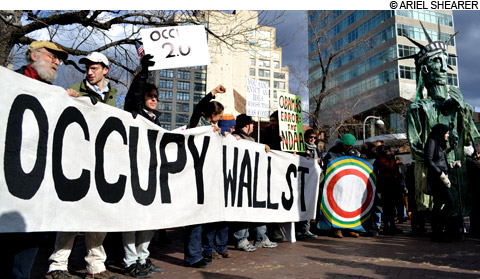
NEXT MOVE Now mostly off the streets, Occupiers need to sustain themselves and stay connected. |
After barreling straight ahead for more than three months, Occupy is at its first fundamental turning point.Encampments in city after city have been eviscerated and plowed under. In Boston, after a judge ruled that the Dewey Square Occupation wasn't protected as free speech, protesters — with the help of police — broke camp and dispersed. All this while critics say the movement has to either take a new form or perish.
But in fact, Occupy has been moving toward that new form for months. Since early October, hundreds of activists from Occupations nationwide have been building connections by phone, e-mail, and Internet relay chats. Now, despite lower public visibility, this network is metamorphosing into something stronger and more sustainable — approaching what renowned group dynamics guru Clay Shirky calls "movement nirvana."
The biggest question now is what form the mature revolution will take. Not everyone agrees on whether to prioritize direct action or longitudinal strategy. This split played out over the weekend of Occupy Wall Street's three-month anniversary: on December 17, several hundred protesters rallied from lower Manhattan to midtown, and nearly 50 people were arrested for trying to set up a new camp. The following day, with much less media fanfare, more than 500 activists also met at two separate conferences in New York to map out the future of Occupy. In one of those summits — a symposium at the New School titled "Occupy Onwards" — Yotam Marom of OWS's direct-action working group attempted to strike a balance between the two sides.
"We can't expect to be in the headlines every day," said Marom. "So far, we punctured the narrative — that this is how things are, that there is no alternative, that people in America don't fight back, and that if you want to protest you have to get a permit. But we've just broken a crack in it, and we're just now getting to see what's on the other side."
NETWORKING
While Marom and a number of core contributors have been strategizing from Occupy's Manhattan mothership, activists elsewhere also started planning early on for the future. Joan Donovan is one of them. In October, Donovan, a Los Angeles–based sociologist, began participating in national conference calls that were first orchestrated by the Occupy Wall Street communications team, and that are now planned daily by her and others who coordinate interoccupy.org.
Within weeks of its inception, InterOccupy had hundreds of participants, many of whom wished to connect with not just other Occupations, but with people from specific working groups in distant places. Now, three months into Occupy, there are regularly scheduled cross-continental calls between food workers, general-assembly facilitators, and direct-action organizers, among others — the latter of whom Donovan says orchestrated the recent West Coast port shutdowns over a series of calls that lasted up to five hours apiece.
"The way the network works," says Donovan, "is that nodes are fairly independent of one another. It's like the way ginger grows. If you take off a knuckle in one place, and re-plant it somewhere else, it will grow back strong. The movement is experiencing this in a rapid form. You have these Occupations that work independently of each other, but we rely on each Occupation recognizing the ethic of the movement — that we are nonviolent, and that we are targeting the one percent."